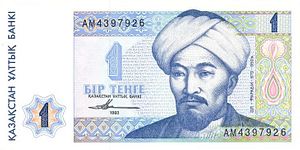On July 10, the two largest banks in Kazakhstan started the process of combining their ATM systems, sanctioning the completion of Halyk Bank’s takeover of Qazkom, something that local financial newspapers are calling “the deal of the year.”
The deal was closed on July 5 for just two tenge, about half of a U.S.cent at today’s rate. Halyk gave one tenge to Kenes Rakishev, a rampant businessman who bought out the original Qazkom shareholders over the past three years, and one to Samruk-Kazyna, the government’s holding company, which also serves as the sovereign wealth fund and heavily intervened in the banking sector following the Global Financial Crisis of 2007-08. In return, Halyk received 98.61 percent of the common shares of its main banking rival.
Before the deal was concluded, however, the parties agreed that Qazkom, formerly known as Kazkommertsbank, had to ensure good standing in its position as a creditor of BTA Bank. BTA was founded by businessman-turned-politician Mukhtar Ablyazov, who, according to Kazakhstan’s prosecutors, stole billions of dollars from the bank before leaving the country and rousing opposition to the regime of Nursultan Nazarbayev from abroad. Both because of the mortgage crisis and these fraud allegations, BTA had accrued a massive share of non-performing loans, debt which banks deem impossible to retrieve from the debtor. Qazkom bought BTA in 2014 and shouldered its toxic assets in its balance sheet. Now, the agreement with Halyk explicitly states that BTA will have to repay the 2.4 trillion tenge ($7.4 billion) towards Qazkom for the deal to finalize.
Halyk reported the completion of the buyout with solemnity, as Kazakhstan’s banking sector will now be completely reconfigured. Halyk Bank chairwoman Umut Shayakhmetova emphasized the role of the state in making sure that the deal would create a stronger actor in the country’s financial sector.
“The involvement of multiple parties, including the state, as represented by the Central Bank of Kazakhstan, the Ministry of Finance, and Samruk-Kazyna, provides further testament to the scale of the transaction. In particular, I would like to highlight Halyk Bank’s unprecedented focus on organizing comprehensive due diligence of Kazkommertsbank, to ensure successful completion of the deal,” Shayakhmetova said.
As the deal closed, Halyk recapitalized Qazkom by 185 billion tenge ($567 million). Bloomberg had previously forecasted a much larger effort, around $738 million, but Halyk said its calculations allowed it to conclude a profitable deal.
In an interview with financial outlet Kapital.kz, Shayakhmetova said that the lengthy negotiations for the deal hinged specifically on the health of BTA assets in Qazkom.
“It would have been suicidal for Halyk to go ahead before having in place every measure to improve Qazkom’s position and balance,” she said. “Our first condition was that BTA repaid at least 60% of its debt towards Qazkom. This was accomplished by transferring around 650 billion tenge to the National Fund for Troubled Assets.”
In essence, the government fund shouldered around $2 billion of BTA’s toxic assets before Halyk would even consider the buyout. Shayakhmetova clarified that the role of the government in guaranteeing the stability of the deal was massive. And it might have been inevitable for a transaction that created a super-giant bank, which today controls 38 percent of the market share in the country.
A few questions will continue to haunt the observers who followed the long saga around BTA, Qazkom and Halyk. BTA was linked to Ablyazov and bailed out by Samruk-Kazyna. Qazkom was linked to Nurzhan Subkhanberdin, a one-time friend of president Nazarbayev, who had allegedly fallen out of favor. Rakishev, the principal businessman who bought Subkhanberdin out, has links to the elite, being married to current ambassador to Russia Imangali Tasmagambetov’s daughter. Halyk’s owners are Timur Kulibayev and his wife Dinara, Nazarbayev’s daughter.
So, why did the Kulibayevs refuse to buy BTA Bank when Samruk-Kazyna pushed the deal in 2013? Why did Qazkom end up with such toxic assets in its balance sheet just a few months later, and just a few days before a major devaluation of the national currency? Why did Rakishev buy out Qazkom’s original shareholders, just months before selling it all out to Halyk?
Analysts are divided between those who think the deal was entirely a political game and those who find a financial rationale between the buyout. The deal will change the face of Kazakhstan’s banking sector and the government will have to continue to watch the new super-giant, which now is undoubtedly too big to fail.

































